Last Updated on January 22, 2023
The warlock’s hands extend, twisting into a forbidden shape as her mouth utters foul words that ring out across the planes. Far away, far below her feet in a nightmare dimension of blood, bone, and darkness, something hears her call.
The ground shudders, as though fighting in vain against the urge to vomit. The air fills with half-discernible screams, and the shadows writhe with momentary life of their own.
Heralded by the blaring of ancient bronze horns and the stink of sulphur, crawling and clawing and slithering its way between the dimensions, the entity worms its way into our world.
“Yes, master? What is your will?”
Welcome to our guide to using the Summon Greater Demon spell in Dungeons & Dragons 5e. We’ll be going over what this spell does, how it works, what kinds of demons you can summon, and how to get the most out of this thoroughly risky ability.
Summon Greater Demon is a 4th-level spell that was added to the warlock and wizard spell lists as part of Xanathar’s Guide to Everything. Using a combination of unholy words, gestures, and a vial of blood from a humanoid who died in the last 24 hours, you call forth a demon from the Abyssal Plane and temporarily bind it to your will.
Summon Greater Demon
Level: 4th
Casting Time: 1 Action
Range: 60 ft
Components: V, S, M * (a vial of blood belonging to a humanoid that died within the past 24 hours)
Duration: Concentration, 1 Hour
School: Conjuration
Attack/Save: None
You utter foul words, summoning one demon from the chaos of the Abyss. You choose the demon’s type, which must be one of challenge rating 5 or lower, such as a shadow demon or a barlgura. The demon appears in an unoccupied space you can see within range, and the demon disappears when it drops to 0 hit points or when the spell ends.
Roll initiative for the demon, which has its own turns. When you summon it and on each of your turns thereafter, you can issue a verbal command to it (requiring no action on your part), telling it what it must do on its next turn. If you issue no command, it spends its turn attacking any creature within reach that has attacked it.
At the end of each of the demon’s turns, it makes a Charisma saving throw. The demon has disadvantage on this saving throw if you say its true name.
On a failed save, the demon continues to obey you. On a successful save, your control of the demon ends for the rest of the duration, and the demon spends its turns pursuing and attacking the nearest non-demons to the best of its ability.
If you stop concentrating on the spell before it reaches its full duration, an uncontrolled demon doesn’t disappear for 1d6 rounds if it still has hit points.
As part of casting the spell, you can form a circle on the ground with the blood used as a material component. The circle is large enough to encompass your space.
While the spell lasts, the summoned demon can’t cross the circle or harm it, and it can’t target anyone within it. Using the material component in this manner consumes it when the spell ends.
At Higher Levels. When you cast this spell using a spell slot of 5th level or higher, the challenge rating increases by 1 for each slot level above 4th.
Source: Xanathar’s Guide to Everything
Let’s break this down.
The Summon Greater Demon spell at first sounds like a souped-up version of Summon Lesser Demons, a 3rd-level incantation also available to the warlock and the wizard. However, in practice, the spell is significantly less chaotic.
Summon Lesser Demons just rips a hole in reality between you and one of the (relatively) less awful parts of the Abyssal Plane, scooping up whatever it finds there with the magical equivalent of a big butterfly net.
You can end up with anywhere between two and eight demons of varying CR, all of which arrive on the material plane in a state of confusion and anger and are definitely not under your control. It’s basically a way to disrupt groups of enemies, derail a ritual, or otherwise sow chaos, death, and destruction in a particular location.
While you can very much use Summon Greater Demon to accomplish this same goal, the potential applications for this spell are a lot more varied.
By using a single action, and burning a spell slot of 4th level or higher, you reach into the Abyssal realm and pull forth a demon of your choice. If you know the true name of the demon you want to summon, you can summon them specifically (they’re also less well-equipped to resist your commands) or you can cast a wider net and grab a random demon from a type that you choose.
Gaining access to a CR 5 summoned creature using a 4th-level spell slot is incredibly powerful. Demons are some of the most varied and weird monsters in all of D&D, and being able to bend one to your will for up to an hour is not only mechanically impactful but is probably just about the most metal thing you can do as an eldritch spellcaster.
Summon a Dybbuk to possess the corpses of your enemies; call forth a Shadow Demon to add the ultimate assassin to your forces, or bind the fearsome Tanarukk in service to you for a nigh-unstoppable brute.
A User’s Guide to Summoning Demons
If you’re playing a warlock, you can summon any demon of CR 6 or lower by upcasting this spell to 5th level. That’s a great place to start.
However, if you choose to take this spell as one of your higher-level Mystic Arcanum spells, or are playing a wizard with access to higher-level spell slots than you get through Pact Magic, then you can theoretically summon a demon of up to CR 10 with a 9th-level spell slot.
Unless I’m very much mistaken, this is the most powerful summoning ability in the whole game. At CR 10, you can start calling forth Glabrezus, Shoosuvas, and the nightmarish Yochlol.
That being said, all that power comes at a potentially steep price. Demons (unlike their lawful evil counterparts, the devils) are chaos incarnate, and summoning one of them is more than likely to result in life in the material plane getting a little… exciting. Also quite possibly a lot shorter.
The demon you summon doesn’t actually want to do your bidding, and if you want them to do anything besides indiscriminately slaughter anything in sight (including you), you’re going to need to continue to impose your will upon them every single turn, lest your hold over them be broken.
As such, when you choose a demon to summon, in addition to thinking about its abilities, try to pick something with a low Charisma modifier, so you have a better chance of maintaining your control over it for longer.
Speaking of improving your odds of controlling the demon for more than a few seconds, we should probably talk about the demon’s true name.
The concept of something’s true name-giving others power over it is absolutely ancient and deeply intertwined with both medieval demonic lore and modern occultism.
DM Tip: The Lesser Key of Solomon (otherwise known as the Ars Goetia) is a grimoire on demonology compiled by a group of unknown monks in the 17th century – with additional editing and entries by the infamous occultist Aleister Crowley.
It’s not only an excellent source of visual inspiration (in my games, discrete demons of the same type often look very different, and one demon can change its horrid form from one moment to the next as it glitches in and out of the material plane) but also contains extensive diagrams of the magic circles used to summon specific demons using their true names, as well as an extensive list of demon names.
Demons named in the Lesser Key of Solomon
Bael
Agares
Vassago
Samigina
Marbas
Valefor
Amon
Barbatos
Paimon
Buer
Gusion
Sitri
Beleth
Leraje
Eligos
Zepar
Botis
Bathin
Sallos
Purson
Morax
Ipos
Naberius
Glasya-Labolas
Buné
Ronové
Berith
Astaroth
Forneus
Foras
Asmoday
Gäap
Furfur
Marchosias
Stolas
Phenex
Halphas
Malphas
Räum
Focalor
Vepar
Sabnock
Shax
Viné
Bifrons
Vual
Haagenti
Crocell
Furcas
Balam
Alloces
Caim
Murmur
Orobas
Gremory
Ose
Orias
Vapula
Zagan
Valac
Andras
Flauros
Andrealphus
Kimaris
Amdusias
Belial
Decarabia
Seere
Dantalion
Andromalius
If you know the true name of the demon you summon, you impose disadvantage on the saving throw it makes each turn to resist your control.
Your DM might allow you to uncover the true names of demons in ancient grimoires, scribbled in the notes of fanatical cultists, or by contacting your own patron (if you’re bound in service to an even more powerful entity from the abyss) for a little insider knowledge.
Of course, if you’ve just summoned a random demon, the other way to learn its true name is to ask the demon itself. On the first turn the demon spends in the material plane, it is automatically under your control.
Spending that turn’s action to compel the demon to tell you its true name makes subsequent turns a lot less nerve-wracking and means you can summon that specific demon again the next time you use this spell.
As a DM, I would definitely allow this workaround. Not only is it deliciously devilish, but summoning the same demon time and time again is a great way to develop some narrative beats along your warlock or wizard’s chosen path toward infernal Pokemon trainer.
It’s also worth noting that, while it can’t hurt, fluency in the Abyssal language is not technically required. D&D 5e lead designer Jeremy Crawford has confirmed that the spell magically turns the caster’s verbal commands into comprehensible mental commands for the demon.
However, that doesn’t mean you can understand everything the demon says; asking a demon its name might prompt it to respond in a full sentence – “My true name, though I have many others, is Bar’Zhuul, destroyer of empires and devourer of puppies, seller of subprime mortgages and frequent guest on the Joe Rogan podcast” – which, to someone who doesn’t speak Abyssal, would probably just sound like an orchestra being torn apart by bears at a morris dancing convention inside a food processor.
Or perhaps a mid-2000’s Ska band.
Lastly, you should always carry the material component for this spell and be ready to use it to encircle yourself within a magic ring of blood as soon as your demonic summon breaks out of your control.
Greater Demon Breakdown
Let’s take a look at some of the best demons that you can summon using this spell.
Lesser Demons
While burning such a high-level spell slot on summoning an entity of CR 3 or lower can feel wasteful, there are a few such creatures that have sufficiently interesting or useful abilities to warrant consideration.
Cackler (CR ½), Guildmasters’ Guide to Ravnica: Potentially a great way to disable a high-level foe. The otherwise pretty puny Cackler has access to innate spellcasting, which it can use to throw out some instances of Tasha’s Hideous Laughter (and Firebolt), which can be great if your party lacks battlefield control.
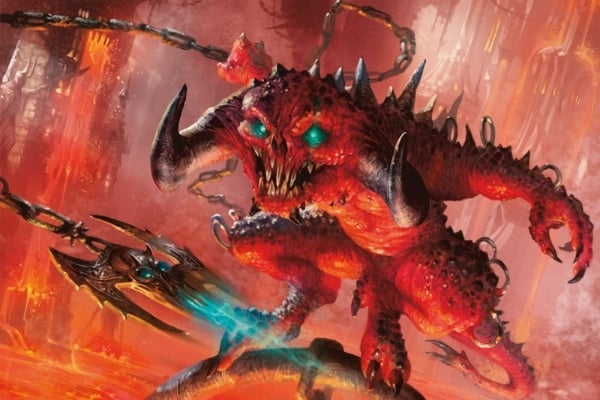
Maw Demon (CR 1), Volo’s Guide to Monsters: A rampaging ball of hunger and teeth. The ability for this demon to use the gnoll’s rampage ability to chain together attacks make it a potentially devastating tool against mobs of low-level enemies. Also, be careful; Maw Demons can’t speak, so you won’t be able to learn one’s true name.
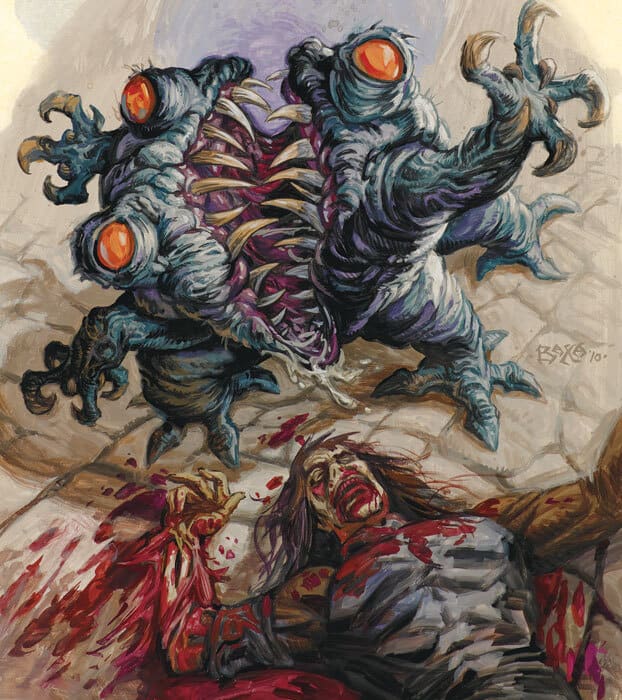
Quasit (CR 1), Basic Rules: Another great low-level utility demon, useful as a shapeshifting, invisible scout, or for its Scare ability. You’re still probably better off using the Find Familiar spell, however.
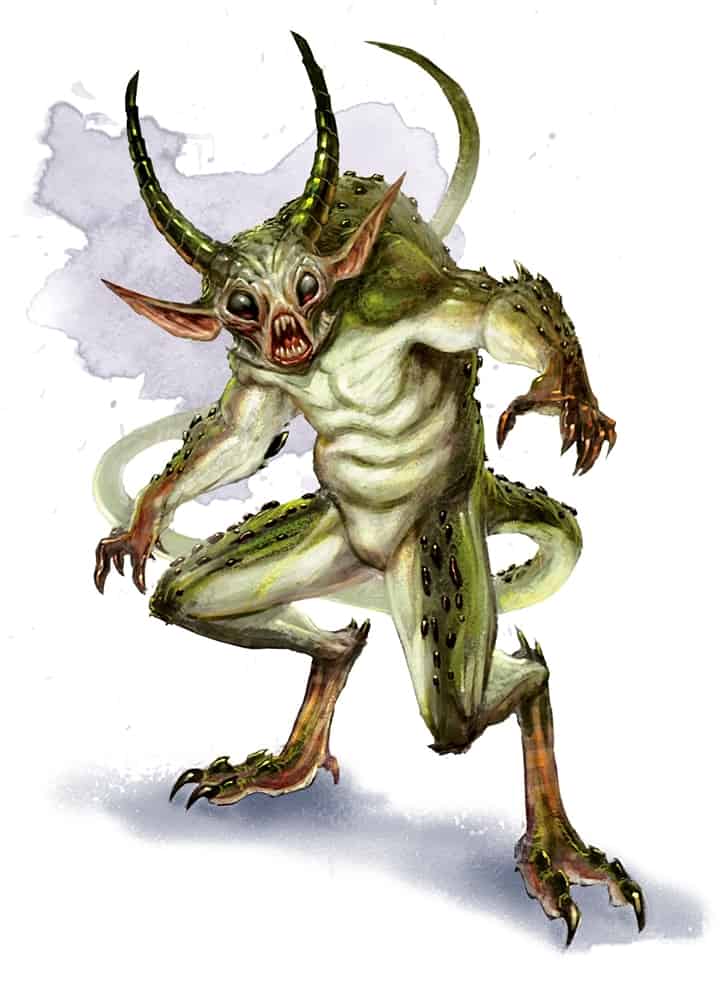
Bulezau (CR 3), Morenkainen’s Tome of Foes: A fantastically satanic goat demon with the ability to poison its enemies. Just be careful with that 30-foot necrotic aura.
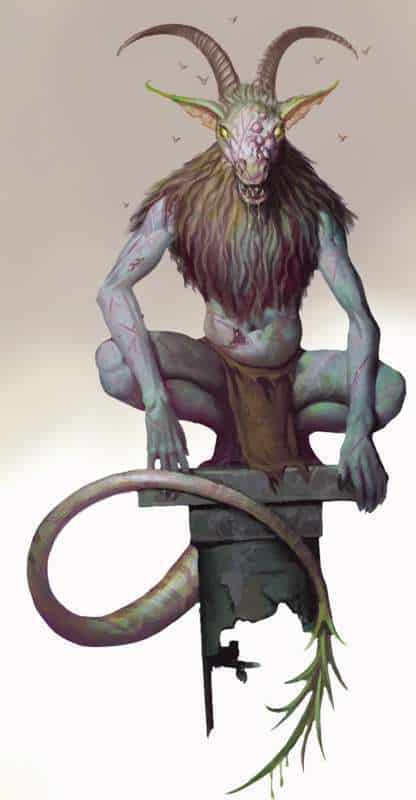
Greater Demons
Anything of CR 4 or higher is definitely getting into greater demon territory, and therefore makes for a great potential summon. Just be careful; the more powerful the demon, the more dangerous things will get if you lose control of it.
Babau (CR 4), Volo’s GUide to Monsters: This H.R. Giger-inspired killing machine combines solid damage output with a Weakening Gaze (DC 13 save or half damage on Strength-based weapon attacks for a minute) and a decent handful of at-will spells, including Heat Metal, Fear, and Levitate.

Dybbuk (CR 4), Morenkainen’s Tome of Foes: Definitely one of the more interesting demonic summons available to you. The Dybbuk is middling in its combat abilities but has a wealth of innate spells, including Dimension Door at will and Phantasmal Force 3/day.
It can also possess a corpse for some Exorcist-style shenanigans like vomiting blood and levitating, impose the Frightened condition on enemies witnessing this awful transformation, and gain access to some of the qualities of the dead creature.
It’s worth noting that there’s no restriction on the type of corpse the Dybbuk can possess. Hello, undead dragon.
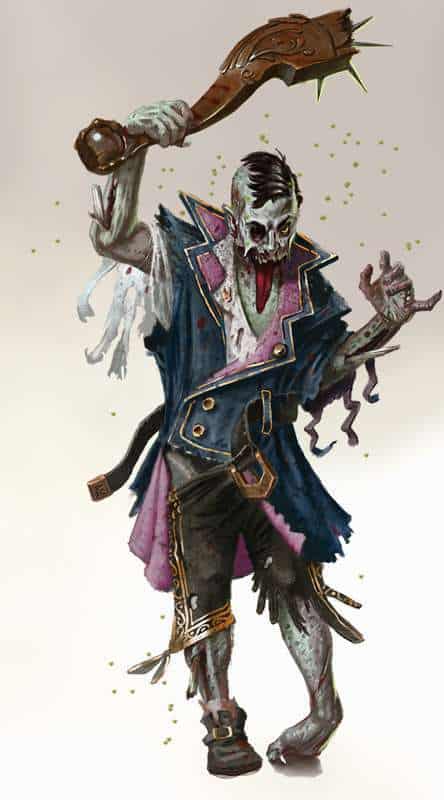
Shadow Demon (CR 4), Monster Manual: A terrifying monster made from living darkness. The major drawback of the Shadow Demon is its sensitivity to bright light. However, in darkness or dim light, it becomes a fantastic ambush predator.

Barlgura (CR 5), Monster Manual: Basically a giant gorilla from hell. The Barluga is a highly mobile brute with the ability to turn invisible, disguise itself, and make a full three melee attacks on its turn.

Tanarukk (CR 5) Volo’s Guide to Monsters: The ultimate demonic brute. Tanarukk’s are formed by the demonic influence of the demon lord Baphomet upon an orcish foetus.
They grow into towering, bestial killers with the added ability to make a melee attack with advantage against any enemy that hits them with a weapon attack, meaning you can throw one into a pile of enemies and enjoy the show.
Also, the Tanarukk has a -1 modifier to Charisma, which makes it more likely to remain under your control for longer.
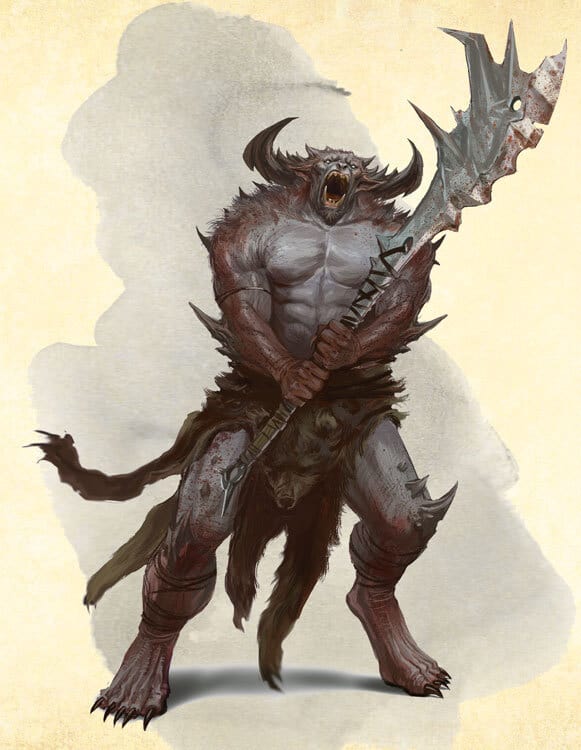
Vrock (CR 6) Monster Manual: A vicious, stupid (also -1 Charisma, which is idea) – the Vrock is has a brilliant mixture of control capabilities, damage output, and flight. Use it to swoop down upon your enemies and stun them with its screech before you begin your assault.
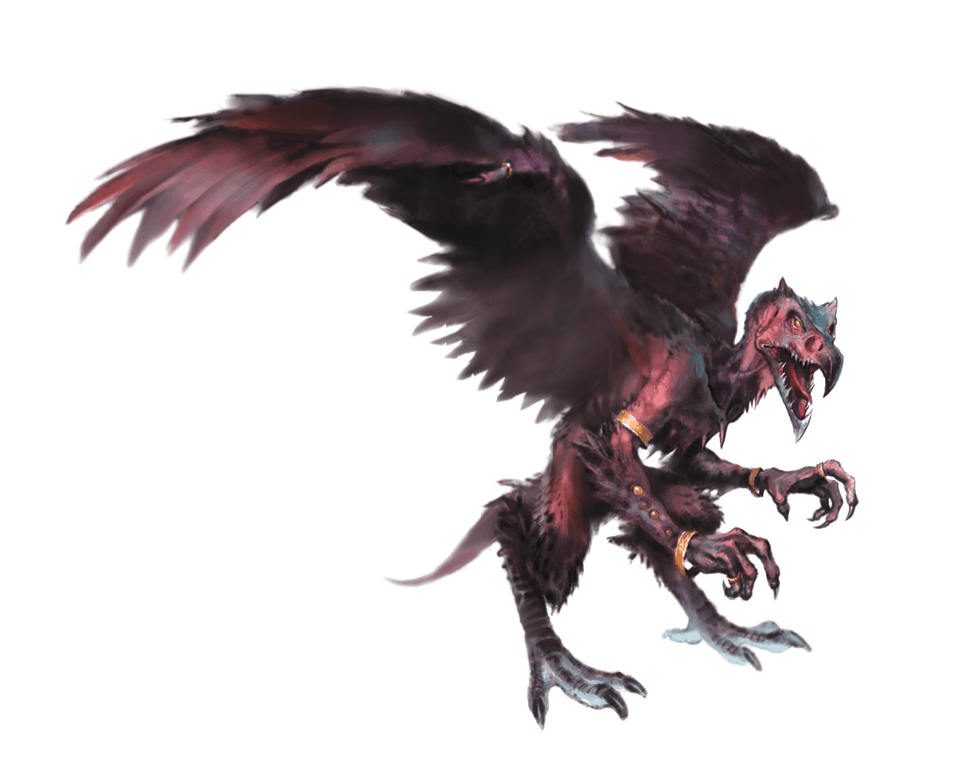
Armanite (CR 7) Morenkainen’s Tome of Foes: Bring some demonic cavalry to the fight with this nightmarish, blood-crazen centaur. Hurl lightning at your foes and trample them underfoot. Just beware of its +1 Charisma bonus.
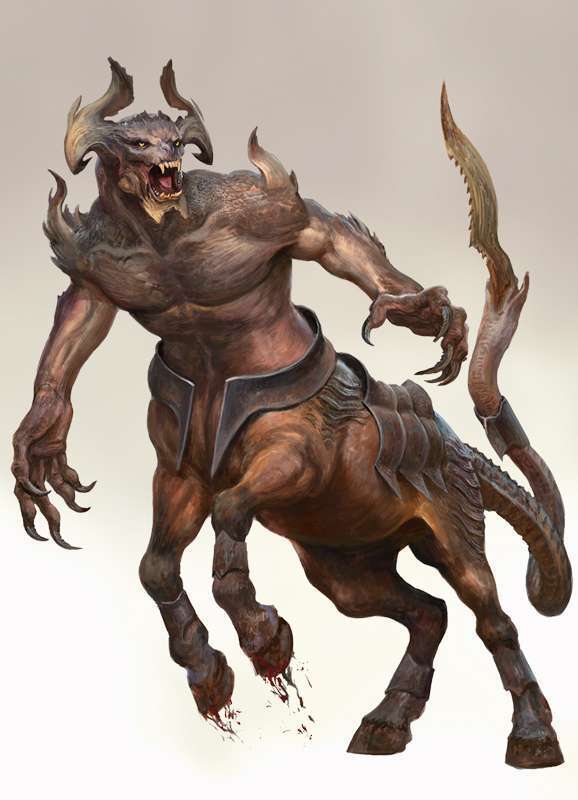
Draegloth (CR 7) Volo’s GUide to Monsters: Deliciously creepy four-armed death ogres, Draeloths usually exist as lethal servants of powerful Drow priestesses.
They actually remind me a lot of the gargoyles from the Castlevania anime.
They can throw out a punishing number of attacks, gain access to the same innate spellcasting as drow (including faerie fire and darkness), and get a juicy +5 bonus to stealth checks, making them the sort of nightmare you unleash into an unsuspecting castle in the middle of the night, then just lie back and listen to the screams.

Hezrou (CR 8) Monster Manual: Hezrou serve as the footsoldiers in the demonic armies. They’re physically powerful, with three powerful attacks, and a poisonous aura.
Be careful, however: a Hezrou has a +1 Charisma bonus and its stench can still reach you within a magic circle of blood.

Shoosuva (CR 8) Volo’s GUide to Monsters: Quite possibly my favorite demon in the whole game, the Shoosuva is an infernal hyena-scorpion hybrid (all the best demons are unholy handfuls from the animal part grab bag) typically gifted to servants of the gnoll god Yeenoghu.
They’re hellishly fast, with two attacks – one of which can paralyze an enemy for easy takedowns – and a -1 Charisma bonus.
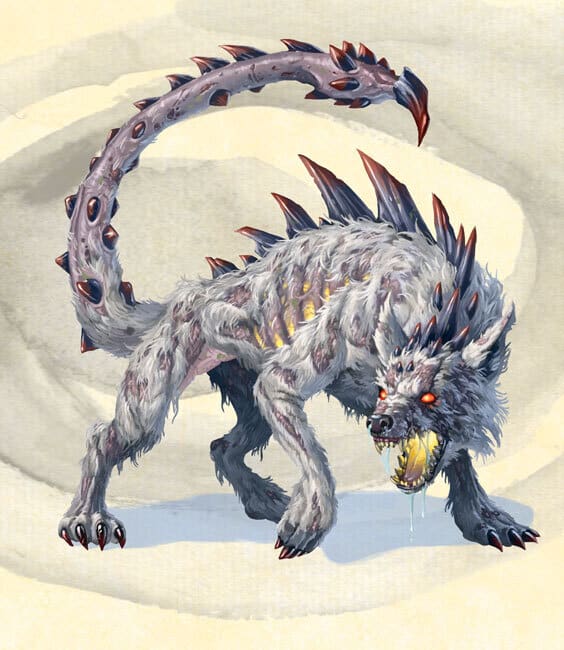
Glabrezu (CR 9) Monster Manual: There are few demons that can match a Glabrezu for sheer combat prowess. They make a full four attacks in combat, and allow you to hit an enemy with the spell Power Word Stun once per day.
Unfortunately, you probably don’t want to try and fight alongside a Glabrezu thanks to their +3 Charisma bonus. It’s definitely better to throw one into a room full of enemies and shut the door behind it.
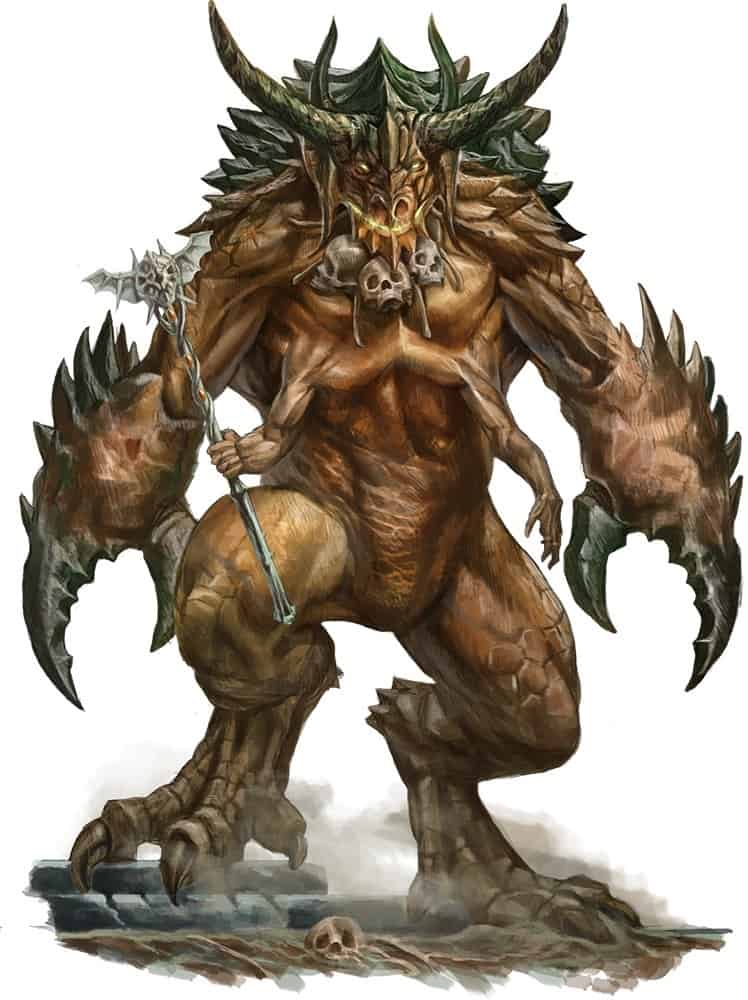
Frequently Asked Questions
How does Summon Greater Demon work in 5e?
Spend an action to cast this spell using a slot of 4th level or higher. Depending on the level of the spell slot used you summon a demon of CR 5 or lower (the CR increases by 1 for each level of spell slot you use above 4th) that is under your command for the duration (1 hour).
If you know the true name of a demon, you can summon it using this spell or, if you don’t know the true name, you specify the demon’s type. At the end of each of its turns, the demon makes a Charisma saving throw (at disadvantage if you know its true name).
If its save succeeds, it ceases to be under your control, although you must stop concentrating on the spell in order for the demon to disappear within 1d6 rounds.
Can you twin Summon Greater Demon?
No. According to 5e lead designer Jeremy Crawford, a twinned spell must only be able to target one creature or object.
Because Summon Greater Demon “appears in an unoccupied space you can see within range”, it’s not a targeted spell and therefore can’t be twinned.
Can you use a spellcasting focus for Summon Greater Demon?
Yes, but you won’t be able to create the magic circle that prevents the demon from attacking you if it breaks out of your control, so I wouldn’t advise it.
Can you dispel Summon Greater Demon?
Summon Greater Demon is not an instantaneous effect, so you could theoretically use Dispel Magic to end its presence.
However, because you could argue that the 1d6 additional rounds the demon remains are due to its own lingering power and not the spell, Dispel Magic probably wouldn’t eliminate this effect. Better to use something like Dispel Evil and Good or Banishment for immediate results.
I played my first tabletop RPG (Pathfinder 1e, specifically) in college. I rocked up late to the first session with an unread rulebook and a human bard called Nick Jugger. It was a rocky start but I had a blast and now, the better part of a decade later, I play, write, and write about tabletop RPGs (mostly 5e, but also PBtA, Forged in the Dark and OSR) games for a living, which is wild.

Hi
I think the Dybbuk comes with some restrictions on the type of corpse it can possess.
Mordenkainen’s Tome of Foes describes the abillity as such:
Possess Corpse (Recharge 6). The dybbuk disappears into an intact corpse it can see within 5 feet of it. The corpse must be Large or smaller and be that of a beast or a humanoid. The dybbuk is now effectively the possessed creature.
As a dragon is neighter beast nor humanoid the Dybbuk cannot possess the corpse.
Hi,
It seems reasonable to assume, as you write, that if you are using a spellcasting focus you won’t be able to use the material components for the circle. Is that your own interpretation and is it based on any other rules out there? Or did you just take the common sense approach that you can’t really pour blood out of a wand or a holy symbol? And how would it work with a component pouch? The components are used up, but they don’t cost anything so they’re always in the pouch, right?
I’m not trying to say that what you wrote could be wrong, rather I feel the spell isn’t clear how the components are meant to be handled.